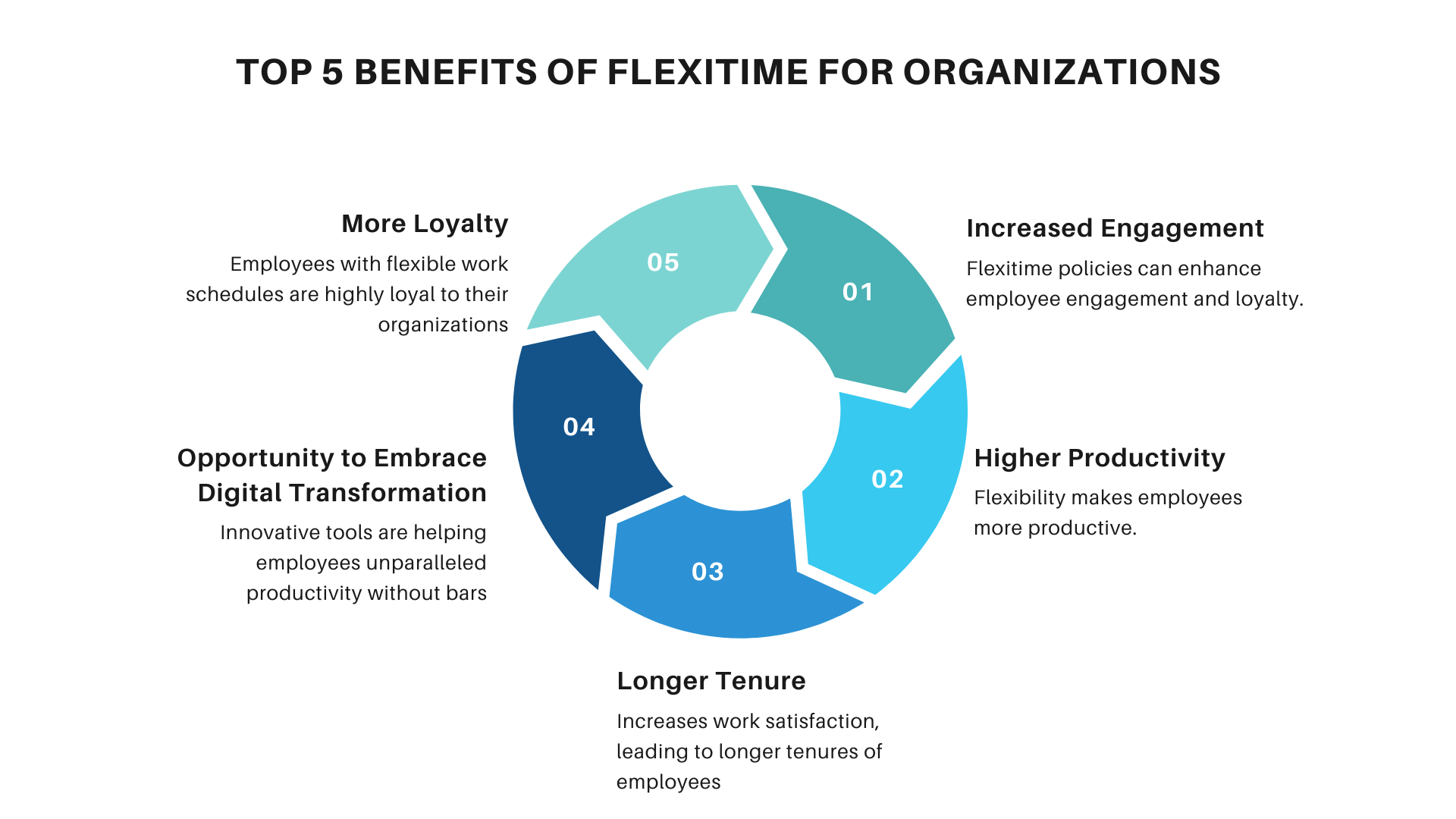Worldwide, employees are embracing the newer and more productive working style, Flexitime or flexible working schedules. A significant 54% of employees express a willingness to leave their current jobs for companies offering flexitime according to a Gallup research report. This figure highlights how profoundly the flexitime concept has impacted the work-life balance of employees. Furthermore, employers too can save massive financial resources by introducing flexible timings, saving majorly on overhead and operational costs.
But, what does flexitime mean?
This blog will define flexitime and unravel its impact on enhancing employee productivity.
What Is Flexitime?
Flexitime is a unique and interesting concept that embraces the flexible workstyle, allowing employees to fulfill their required work hours with a degree of flexibility. For instance, if an employee must complete 40-45 hours per week or work 8-9 hours daily, they have the liberty to accommodate their individual needs with their professional responsibilities.
Let’s explain it with an example. If an employee has to leave the office due to sudden emergencies at home, they can work from home or work more than their daily timeframe from anywhere to achieve their daily or monthly goals. What’s important to note is that a digital time tracker is crucial to enable flexitime in organizations. Time trackers like KonarkPro help track the work hours of employees and manage their productivity by streamlining their activities.
In essence, flexitime liberates employees from the constraints of rigid work schedules that often hamper productivity and diminish work quality. Moreover, it enables employers to produce a conducive environment for their employees and facilitates conditions to trigger their peak productivity.
A Brief History
The concept of flexitime takes us back to the 1960s when a reputed aerospace German company Messerschmitt-Bölkow-Blohm (MBB) was located and operational in Munich. The company faced multiple challenges in organizational productivity and daily operations due to many bottlenecks in car traffic, leading to late arrival and leaving offices early, overall frustration with the job, and less productivity. Consequently, a sociologist, Kristel Kammerer was assigned the responsibility by MBB to alleviate the problem and suggest solutions.
From her defying the idea of the ‘9-5 clock pattern,’ emerged this novel and unique concept of ‘Flexitime’ AKA ‘Flex time.’
Flexitime: An Effective Approach for Employers
Introducing a flexible approach to work schedules serves as a powerful tool for motivating the workforce and fostering positive relationships between organizations and employees.
For small businesses, flexible working schedules offer substantial benefits. According to insights from the Equality and Human Rights Commission and the British Chamber of Commerce, a vast majority of surveyed small businesses reported minimal setup costs associated with implementing flexible work schedules. Additionally, a significant percentage reported positive impacts on employee-employer relationships, staff retention rates, and overall productivity.
The prevalence of flexible work arrangements has become increasingly apparent, especially as employees recognize the advantages of remote and flexible work settings. According to the Gartner 2021 Digital Work Experience Survey, a substantial portion of respondents attributed increased productivity to flexible work hours. Resultantly, businesses adopting flexible work schedules can benefit from cost savings associated with employee retention, minimizing expenses related to talent acquisition and training programs.
The Microsoft New Future of Work Report 2022 highlights the evolving definition of productivity, that emphasizes more on enhanced well-being, improved work-life balance, and organizational inclusivity. This highly resonates with flexitime. Hybrid and remote work styles and flexible work cultures play pivotal roles in fostering these desired professional attributes. Additionally, digital collaboration tools facilitate seamless global operations, addressing time zone disparities and other adversities.
Furthermore, flexible work schedules contribute to employee satisfaction and long-term organizational planning. Whether it’s accommodating urgent personal life or simply adjusting lunch breaks, flexibility significantly reduces employee turnover rates in an organization.
What Are the Benefits of Flexitime for Organizations?
The surge in the adoption and embracing of flexitime more than ever can be attributed to a myriad of benefits it offers to organizations.
Let’s delve into its benefits.

Increased Engagement
A flexible work schedule introduces convenience and adequate work-life balance into employees’ lives. This creates opportunities where flow state and high creativity phases are prioritized over the conventional and mundane 9-5 clock pattern. Employees whose work schedules are aligned with their personal lives exhibit high productivity because their work schedules resonate highly with the bursts and gusts of productivity and engagement throughout the day.
Higher Productivity
Flexitime introduces adjustability in life, highly admired by employees. An employee who has to compromise a lot on their personal life is often unproductive. More stress, disturbed work-life regimes, and lack of social interaction produce a negative impact on work behavior and staggers productivity. Conversely, flexibility at the workplace allows employees to tweak their professional routines to ease their personal lives and vice versa. This ability to conveniently modulate working patterns without sacrificing productivity is the ultimate benefit of flexitime.
Longer Tenure
Companies with more flexible work schedules have comparatively more contented employees who achieve excellent control and balance between work and pleasure. This breeds more loyalty in employees and significantly increases work satisfaction, leading to longer tenures of employees. Furthermore, employees with more flexibility show more warmth and respect toward their work culture, preventing moonlighting or exiting.
Opportunity to Embrace Digital Transformation
Revolutionary technologies are transforming the work style. From project management to the time tracker, innovative tools are helping employees unparalleled productivity without bars. With more disbursement of technical devices and connectivity, higher productivity and refined quality in tasks can be drawn without limitations. Tools available today help, from HR to developers to drive outcomes with greater efficiency, accuracy, and effectiveness.
More Loyalty
Employees with flexible work schedules are highly loyal to their organizations. They act like brand advocates within their social circle. Such employees help boost brand recognition and generate more opportunities for business growth. Also, studies confirm the candid endorsement of companies through employees is an unfailing strategy to bolster the network across the globe. Loyal customers have positive insights about their company to communicate to the world. This inherent marketing practice is known as employee branding, a more powerful method than other marketing strategies. Employee branding helps users see an organization from an employee’s perspective and expands new horizons for brand recognition.
Conclusion
In conclusion, flexitime is rekindling workplace dynamics. From prioritizing productivity and quality over traditional workplace setup with strict work hours, flexitime is exceptionally enhancing workplace productivity.
By embracing flexitime, employers can leverage time management tools and adapt to the evolving digital landscape.
Powerful time management tools like KonarkPro can help seamlessly integrate flexibility and work-life balance into an organization. Its intuitive technology enables employers to track remote work performance and productivity without intrusiveness.
FAQ
How can I introduce a flexible work schedule in my organization?
You can use smart time trackers to monitor employees’ performance even when they are working off-site. It will assist employees in completing their tasks without having to stay at the workplace.
What other flexibilities can I offer to my employees?
Flexibilities, such as remote and hybrid work, working on weekends, task sharing, and compressed work weeks are several flexibilities that help employees stay productive on the curve.
